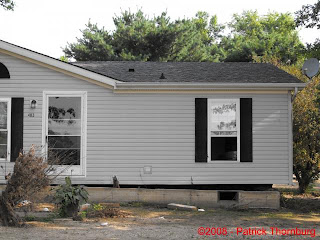
Someone asked why this work was even being done? If the home had flood insurance, and most did not, the inspectors wanted to see all of the damaged items and structure. If there was no insurance, the property may be able to be salvaged. This can only happen if you could mitigate the damage which meant removing all of the items.
Any insulation within the walls soaked up water and helped cause mold growth. One friend's home had a solid mass of mold growing on every wall to a line 5 feet high. Mold could also grow within the wall cavities. So removing the drywall and plaster is a required step.
The house below was torn from its foundation and carried more than 5 blocks and deposited in a ditch.

The surge knocked nearly every mobile home off its foundation. Most have "red tags" on them to indicate they are not safe to enter. These homes may not have been entered in over six weeks.

Even though the Iowa DOT has been picking up debris, more is placed on the curbs each day. Second Street below is lined with damaged property, appliances and demolition debris.

FEMA pulled its Disaster Recovery Center from town on July 28. The Red Cross is planning on providing meals until August 3. Alliant Energy has restored electric power to town but buildings have to be inspected before power is turned on to each house.














































